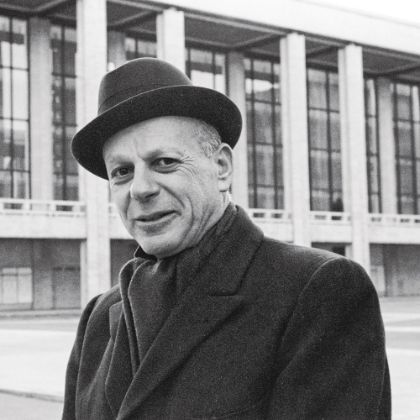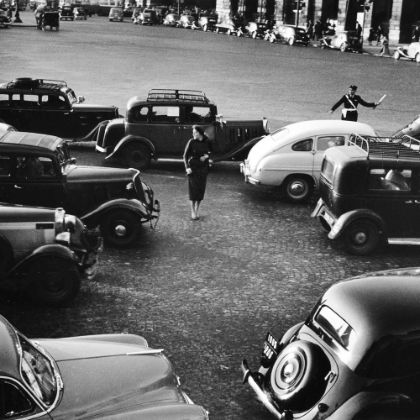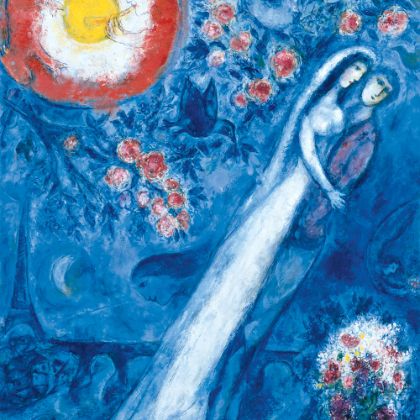Blackstar and the Spiders From Jazz
The inspiration behind David Bowie’s final album
By Bradley Bambarger
David Bowie was on a roll — again. The rock icon had begun his twenty-first century with two energized studio albums and one of his most acclaimed world tours, before that momentum hit the brick wall of his heart attack in 2004. But after nearly a decade of recuperating and lying low — mostly just enjoying an art-loving life in New York City with his family — Bowie released the dream-like ballad “Where Are We Now?” as a single on his sixty-sixth birthday, the song sounding like a man looking at a movie of his memories. The Next Day (Columbia) — a comeback album produced by Bowie and longtime studio partner Tony Visconti with a crew of musicians familiar from recent recordings — followed soon after in 2013, the project’s air one of fresh, fertile-minded reconsolidation. The future seemed bright.
Duly, the next year brought one of Bowie’s boldest creations in a career brimming with them. A lifelong lover of jazz who regularly pulled out his alto and baritone saxophones in a painterly way on record, Bowie collaborated with multiple Grammy Award–winning jazz composer Maria Schneider and her big band, an ensemble filled with some of New York’s finest improvising musicians. Bowie was a fan, having seen Schneider conduct the group at Manhattan’s Jazz Standard. The two co-wrote the single “Sue (Or in a Season of Crime),” a masterpiece of noir atmospherics and art-first impetus that allied her Gil Evans-evoking gift for harmony and orchestration with his genius for melody and oblique storytelling. It led off Nothing Has Changed, a three-disc collection of Bowie hits and rarities; the seven-and-a-half-minute song sounded like nothing else in his canon, except that it was as pioneering in its way as his peerless mid–Seventies music.
In a 1997 interview, Bowie explained how he preferred the art of the unexpected, saying: “A girl wearing a red dress in a forest will be some strange vision of unexpected eroticism, but a girl wearing a red dress on a catwalk will be highly predictable.” The melding of art-rock song craft with big-band jazz orchestration in “Sue (Or in a Season of Crime)” was very much the sound of surprise, like that metaphorical girl wearing a dress in a forest.
The experience of working with Schneider and her orchestra led directly to the making of Bowie’s final album, Blackstar, released on January 8, 2016, his sixty-ninth birthday, just two days before his death from cancer. His end was shockingly sudden for all but his inner circle, the illness having been kept a Pentagon–level secret. Fittingly, and amazingly in this age of dissipating privacy, all the pre-release press for the new album focused on its venturesome content, not its poignant circumstance. The release of Blackstar was ideally stage-managed. As Visconti has pointed out, even Bowie’s death was a work of art.
Instead of working with the rock musicians who had helped him craft his past few albums, Bowie — as he had done on so many occasions in the past — ripped up his playbook and started anew. This time, he tapped a small band of New York jazzers, most of whom are also members of the Maria Schneider Orchestra. Saxophonist Donny McCaslin, a featured soloist in “Sue (Or in a Season of Crime),” had especially impressed Bowie, so Schneider suggested that he check out McCaslin’s own quartet, which mixes electronics with improvisation. Not only buying the records, Bowie took Schneider with him to see the virtuoso’s band at the 55 Bar, a grittily intimate jazz outpost in the West Village. Bowie was thrilled by the quartet’s rhythmic drive, as well as by its mix of the organic and synthetic.
The spiders from jazz
Even before “Sue (Or in a Season of Crime)” and Blackstar, Bowie had worked with top jazz musicians, such as drafting avant-garde trumpeter Lester Bowie (no relation) from the Art Ensemble of Chicago to play on his 1993 album Black Tie, White Noise. He had collaborated with Pat Metheny, co-writing and recording the grand ballad “This Is Not America” with the guitar star and his group for the soundtrack to 1985 film The Falcon and the Snowman.
Reflecting on that experience after Bowie’s passing, Metheny said: “Watching David do his vocal was something I will never forget. I can only say that it was masterful — kind of like the feeling I have had whenever I’ve had the chance to be around a great jazz musician who carried a one-of-a-kind presence that filled every note that came out of them... It doesn’t surprise me at all that his last recording includes some of the best contemporary players in New York, such as the fantastic Donny McCaslin. During our time together, David expressed a real appreciation and knowledge of this music and saxophone players in particular. He carried the broad view of art that was inspiring to me.”
Schneider uses that same word — “inspiring” — to relay the impact of working at close quarters with Bowie. “David was just so fearless,” she says. “He knew that what we were doing might divide opinion among fans and critics, but he embraced that — and it was an inspiring lesson. He was comfortable on the edge. In the studio, he was so passionate and full of creative energy, as well as so open-minded. You could tell that he knew so much music, and what he didn’t know, he wanted to know. David loved jazz and the big-band sound. You could tell that it was a real gas for him in the studio with all the guys.”
Schneider’s music has become more radiant in recent years, but Bowie was after more shadow than light. “He’d keep saying, ‘darker, darker,’ and of course, that suited the story of the song, where Sue dies at the end,” she says. “Now I love how dark the palette is, how the song creates its own universe. I told him that after all my striving for serenity in my music, he’d ruined me with ‘Sue.’ He joked back, ‘Well, my work is done here, then.’ Really, I was just overjoyed and so proud that he loved the track. He said people might look back on it as one of his most forward-thinking pieces of work. We had talked about doing more together, and I left space open in my schedule just in case he would call… Working with David changed me. In some ways, I think of my view of music now as being pre–Bowie and post–Bowie.”
Soon after Bowie saw McCaslin’s quartet at the 55 Bar, he recruited the saxophonist and his group — keyboardist Jason Lindner, electric-bassist Tim Lefebvre and drummer Mark Guiliana — to be his band for the Blackstar sessions, providing them with his detailed home demos of the songs before they went into the studio. Later, guitarist Ben Monder — like McCaslin and Guiliana, a member of Schneider’s orchestra — was added to the mix.
Reflecting on the album’s creation as part of his Bowie memorial comments, co-producer Visconti said in Mojo magazine: “When we discussed using Donny McCaslin’s band for Blackstar, David said: ‘Tony, you have to study them. They’re way above us!’ So we both had to educate ourselves to get up to the level of Donny. Perhaps that’s why David sang every single take that the band did live. Because he was learning it, refining his vocal along with the music.” Referencing Bowie’s early glam-rock outfit Ziggy Stardust & the Spiders From Mars, Visconti added: “David and Donny’s band were hand in glove. They were the Spiders From Jazz.”
The making of Blackstar
Blackstar has parallels with a previous Bowie landmark LP, 1976’s Station to Station. Both albums are comparable in duration and sheer quality, plus each begins with a ten-minute title epic. “Blackstar” is a darkly atmospheric two-part suite, its lyrical images as tantalizingly elusive as light in an obsidian mirror.
Another key track is the affecting “Lazarus,” also the title piece to the off–Broadway musical play that Bowie — incredibly, given his illness — finished concurrently with Blackstar. (The music video for “Lazarus,” depicting Bowie bedridden and dancing like a specter, is haunting.) The album also includes “ ’Tis Pity She’s a Whore,” “Girl Loves Me,” “Dollar Days” and “I Can’t Give Anything Away,” plus a tough, Spartan reworking of “Sue (Or in a Season of Crime).” There is melody in the music and wit in the words, as well as intimations of mortality. The performances have drive and depth, while the richness of the production manages the trick of sounding both of the moment and timeless. Few rock artists have capped their careers with such creative verve as Bowie with Blackstar.
None of the Blackstar players were aficionados of Bowie’s work from one end of his forty-year-plus catalog to the other, with each knowing one or two discrete periods. “‘Let’s Dance’ was part of the soundtrack of my youth, and I knew the earlier hits on the radio,” says McCaslin, forty-nine. “I also liked that song he did with Pat Metheny in the Eighties. So I knew his great stature as a rock artist, obviously, but I’m kind of glad I didn’t know the full range of his catalog, because I might’ve been even more daunted. But working with David couldn’t have been easier — he was so focused and engaged, as well as humble and generous, just wonderful to be around. When we first talked about making the record, he said, ‘Donny, I have no idea how this will go, but let’s have fun.’
The Blackstar musicians all talk about the open, collaborative atmosphere in the studio with Bowie. “He hired us to be ourselves, basically,” McCaslin says. The saxophonist’s best album with his electro-acoustic quartet, 2015’s Fast Future, has a tightly wound concision. Aptly, the mandate for Blackstar was for these jazz-honed players to join Bowie in realizing his music as a sophisticated but ultra-tight rock band; there’s no loose-limbed jamming on Blackstar, with even McCaslin’s solos saying more with less.
About Bowie’s templates for the songs, McCaslin says: “His demos were so evocative — it made the whole prospect of going into the studio really exciting. It was very much rock music, with David’s guitar playing gritty and really distinctive on the demos. But there was something in the songs that had a jazz feel to me, a tension in the chord voicings and the minor ninths and tritones in the harmonies. David’s saxophone playing on the demos was soulful, and I could immediately hear ideas for orchestrations that I could do with tenor sax, clarinet, alto flute and flute. The drum loops and bass lines were strong but in a way that I knew Tim and Mark would be able to take the rhythms to a new level — and David and Tony encouraged them to embellish, to do that mixed-meter thing they do. And when it came to my solos, David and Tony were so encouraging. Most of them were first takes. I think I only overdubbed one to redo it.”
The studio experience was similar for Monder. “David and Tony gave me a lot of freedom to interpret the tunes and come up with sounds that I felt were right,” the guitarist says. “When they liked something, they were excited and vocal about it. Even when they didn’t like something, it was easy. Once I was playing too many notes on something, not really getting it. David just said, ‘Give me some chordal slabs.’ That unlocked it for me, as simple as that. Tony, like David, is great in the studio. He knows how to get the best performances out of people by letting them do what they do. And David’s manner made it such a positive experience for everyone. He was down-to-earth, just a normal, nice guy. I left the studio elated every day, and that’s not always the case.”
Most of the basic band tracks during the Blackstar sessions — including several extras as yet unreleased — were nailed in one or two takes. “David and Tony really appreciated spontaneity,” Lindner says. “They weren’t going for perfection in the performances, but rather vibe and energy.” The trickiest song to capture was the new version of “Sue (Or in a Season of Crime).” At first, the quartet tried to be as faithful as possible to Schneider’s widescreen arrangement. “No one was feeling that path one hundred percent,” explains Lindner, a big fan of the original. “So we decided to strip it back to the bass line and a few integral parts and then just do our own thing in the moment, which was more aggressive — it took on a different life.”
With Bowie singing alongside the band on the studio floor, his vocal presence was a catalyst for the band’s performances. “David singing with us was electrifying,” McCaslin says. “We were playing off each other in the moment, and he was part of that dynamic — the chemistry was immediate. I’d be looking right at him as we were playing, reacting to the passion he was pouring out as he was singing.”
Seeing more and feeling less
Saying no but meaning yes
This is all I ever meant
That’s the message that I sent
I can’t give everything
I can’t give everything... awaydavid bowie, ‘i can’t give everything away,’ blackstar
Although ostensibly “scratch” vocals with the words unfinished, Bowie’s singing in the studio had the vigor of live performance, Lindner says: “He sounded like the rock star he was, powerful and totally personal, individual. Honestly, it made my spine straight and my hair stand on end. The four of us in the band play with a high level of intensity, but when David opened his mouth to sing, he pushed us to play even harder, make the music go deeper. We wouldn’t have been able to play quite like we did without him singing with us. The love for what he did flowed out of him, and you wanted to receive it and radiate it back. He was an art rebel — and you could feel it playing with him.”
With Bowie and Visconti sharing a history going back to 1969, there was an easy rapport between them in the studio that was “beautiful,” Lindner says. There were a lot of tales from the glory days, along with much talk of books, films and visual arts. Bowie not only enthused over “the grandeur” of Charlie Parker’s records with McCaslin; he and Visconti expressed appreciation for the production of rapper Kendrick Lamar’s Grammy–winning To Pimp a Butterfly. There was also a lot of wordplay and “good-natured ball-busting,” Monder reports: “David was so funny in the studio, with this sharp English wit, especially between him and Tim, who’s a pretty funny guy. By the end, though, David was kicking everybody’s ass with the zingers. But he had a sense of humor about himself, too. He had us watch that Eighties video of him and Mick Jagger doing ‘Dancing in the Street,’ but without the music. He was laughing at how ridiculous it looked.”
During the sessions, Bowie informed the band that he was being treated for cancer. “Yet he would be leaving the studio in the afternoon to work with Henry Hey, the music director for the Lazarus theater piece,” Lindner says. “I don’t know where he got all that energy.” Monder adds: “I never saw an indication of his illness in his work, ever. In hindsight, the dark overtones of the lyrics take on a whole new — wrenching — meaning. To me, they’re so much better for how indirect they are, even though you can sense now what the guy was going through.”
Upon hearing of Bowie’s passing, Lindner lit a candle in the dark and played Blackstar for the first time at home, listening all the way through with his girlfriend. He marveled at the detail of the final mix (much pored over by Bowie and company after the initial sessions), though he was ultimately immersed in the album’s emotional impact. “I haven’t been able to listen to it since,” the keyboardist says. “The experience of recording Blackstar was transformative for me in a way that I can’t put into words. And working with David and Tony definitely raised the band to a higher plane.”
McCaslin, Lindner, Lefebvre and Guiliana played a week’s run at the hallowed Village Vanguard in late January. Every set of every night, they played a version of “Warszawa,” an instrumental from Bowie’s groundbreaking Low LP of 1977. “That was Jason’s idea — he could just hear us doing it,” the saxophonist says. “We played it rubato and opened up spaces for improvising. It was always an emotional point in the set. We’ll record ‘Warszawa’ at some point as a tribute.
“There were so many life lessons that came from working with David,” McCaslin concludes. “First of all, there was never wasted time or energy to the way he did things. It has hit me that you never know what’s going to happen ten years or ten days or even ten hours from now. The moment you’re in is all that you know you have, so you really have to live that moment to the fullest. David Bowie did that, right up to the end.”

related...
-

Master Builder
His compatriots made institutions of their music. William Schuman made institutions.
Read More
By Russell Platt -

Respighi: Beyond Rome
Respighi’s set of variations is cast away for his more
Read More
‘Roman’ repertoire.
By David Hurwitz -

L’amico Fritz
Mascagni delivers beautiful music, libretto be damned.
Read More
By Robert Levine